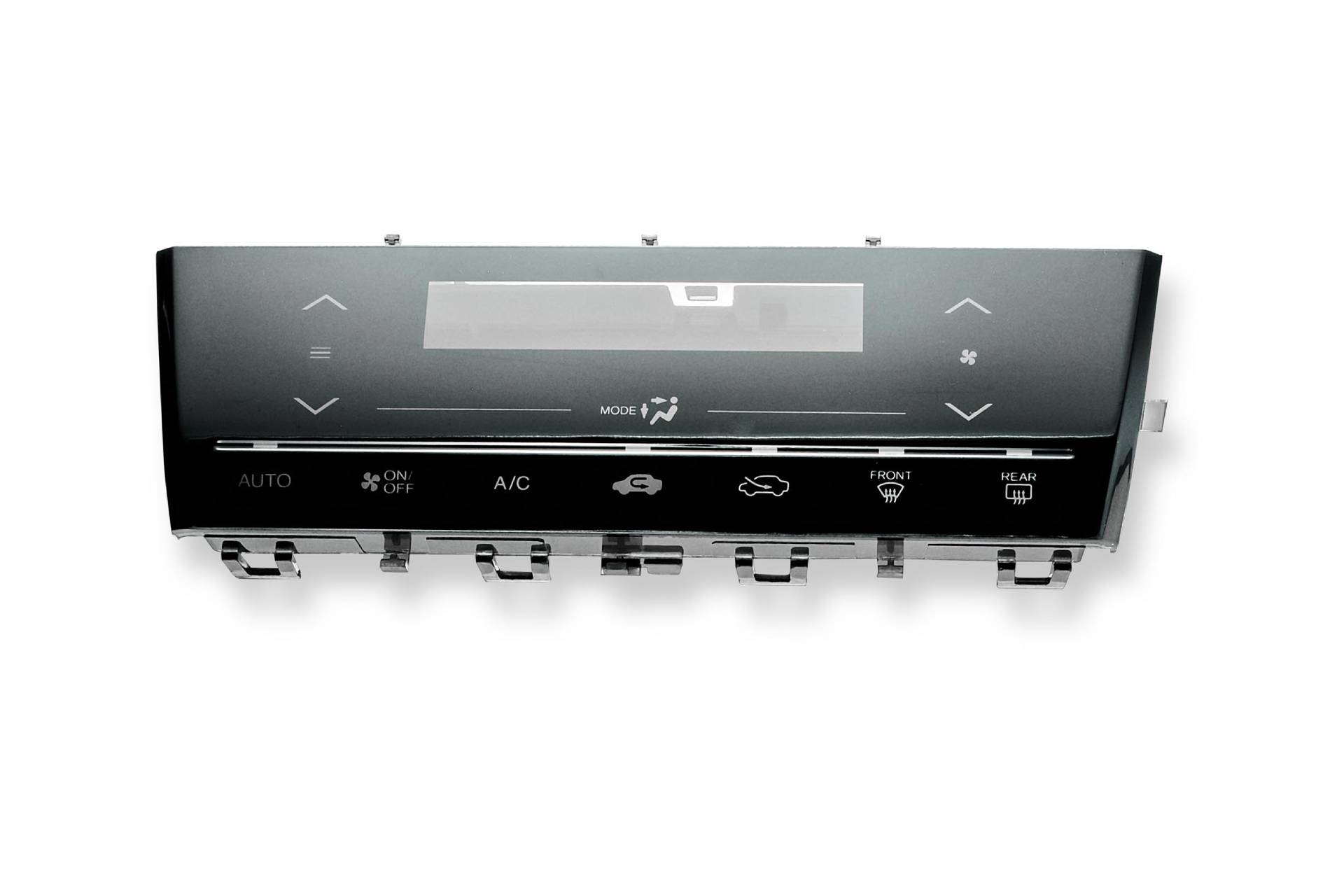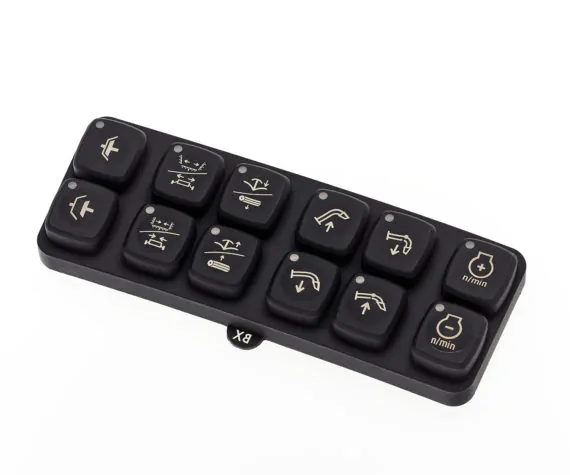Exploring the Production Process Behind Rubber Keypads and Their Relevance in Modern Devices
Rubber keypads are crucial in the capability of contemporary devices. Their production process involves careful selection of materials and exact techniques. Keypads are developed to boost customer interaction while making sure resilience and reliability. Recognizing exactly how these components are made reveals their relevance across different applications. What elements contribute to their effectiveness, and exactly how do these elements affect customer experience? The solutions might improve perceptions of this day-to-day modern technology.
Overview of Rubber Keypads and Their Applications

Rubber keypads are versatile components commonly made use of in various digital tools, ranging from customer electronic devices to industrial devices. Their layout enables a responsive feedback, making them an ideal option for applications needing individual interaction. Commonly located in items such as remote controls, calculators, and medical devices, rubber keypads promote convenience of usage and access.
In industrial setups, they serve essential functions in equipment and control board, where resilience and resistance to ecological aspects are vital. The non-slip surface boosts grasp, advertising reliability in demanding problems. In addition, their lightweight nature and personalized shapes enable makers to develop tailored options that fit details needs. With developments in modern technology, rubber keypads proceed to evolve, including attributes like backlighting and improved level of sensitivity. Overall, their versatility and functional advantages add greatly to the efficiency of different tools throughout several fields.
Products Used in Rubber Keypad Production
Keypad making relies upon a selection of products that improve both capability and resilience. The key product made use of in the production of rubber keypads is silicone rubber, known for its exceptional durability and flexibility. This product permits keypads to endure repeated pushing without losing shape or efficiency. Additionally, thermoplastic elastomers (TPE) are often utilized as a result of their convenience of molding and capability to supply a soft-touch feeling.
Coloring representatives, such as pigments, are incorporated to ensure lively, lasting shades that improve aesthetic charm. Additives like anti-UV representatives and flame resistants might be mixed into the rubber to boost climate resistance and security conformity. The option of materials directly impacts the keypad's responsive feedback, longevity, and total efficiency in different gadgets. Eventually, the cautious option of these parts is vital for the manufacturing of top quality rubber keypads that fulfill customer and market needs.
The Style Refine of Rubber Keypads
When producing rubber keypads, the design process plays an essential function in determining capability and individual experience. Developers begin by defining the keypad's planned usage, thinking about factors such as the tool it will accompany and the target individual market. This initial stage includes mapping out layouts that prioritize ergonomic elements, guaranteeing the secrets are conveniently available and properly spaced.
Next off, designers concentrate on the tactile feedback desired from the keypads, which affects the selection of materials and vital shapes. Prototyping is crucial in this phase, allowing designers to check various styles for comfort and responsiveness.

Production Techniques for Rubber Keypads
The manufacturing process for rubber keypads entails a collection of accurate techniques that ensure high quality and functionality. At first, liquid silicone rubber (LSR) is commonly used because of its durability and adaptability. The process begins with mixing the raw materials, consisting of silicone, colorants, and curing representatives. This mix is after that infused right into mold and mildews created to shape the keypads accurately.
Adhering to injection, the shaped keypads undertake curing, a heating procedure that strengthens the product (Rubber Keypads). This is generally carried out in a press, ensuring the keypads achieve the desired solidity and durability
High Quality Control Measures in Production
To assure that rubber keypads fulfill high criteria of high quality and performance, extensive quality assurance steps are implemented throughout the production procedure. These steps begin with resources examination, making sure that only the highest-grade elastomers are made use of. During the manufacturing phase, operators carry out normal checks to check specifications such as temperature, pressure, and blending times, essential for achieving regular item top quality.
Post-production, each batch of keypads undertakes extensive screening, consisting of tactile feedback evaluations and durability examinations to evaluate efficiency under numerous problems. Visual assessments are additionally conducted to identify any type of issues, such as bubbles or inconsistencies in texture. In addition, conformity with sector criteria is validated, ensuring that the keypads meet safety and capability criteria.
The Function of Innovation in Keypad Development
Modern technology plays an important role in the development of rubber keypads by enabling innovative production strategies that enhance accuracy and efficiency. Additionally, innovative product selection permits enhanced sturdiness and responsiveness in keypad efficiency. These innovations not just enhance manufacturing however additionally raise the general high quality of the end product.
Advanced Production Techniques
Innovations in manufacturing techniques revolutionize the manufacturing of rubber keypads, boosting both performance and accuracy. Technologies such as shot molding and 3D printing have transformed typical procedures, allowing makers to create complicated styles with minimized waste and enhanced turn-around times. Automation plays an important role in this advancement, streamlining assembly lines and reducing human error. Additionally, computer-aided design (CAD) software program allows for intricate customization, ensuring that keypads meet particular individual needs. Quality control procedures have actually additionally progressed, incorporating real-time surveillance systems that discover flaws early in the production cycle. These technologies not just enhance the toughness and performance of rubber keypads yet also support the expanding need for tailored solutions in different markets, from customer find here electronics to automobile applications.
Cutting-edge Product Selection
The development of manufacturing methods has actually led the way for innovative product selection in rubber keypad growth. Advances in polymer science have introduced materials that improve sturdiness, adaptability, and responsive feedback. Producers currently use polycarbonate elastomers (TPE) and silicone compounds, which supply premium resistance to use and environmental aspects. These materials enable the development of keypads that can endure extended usage while keeping aesthetic allure. Additionally, the combination of coverings and additives boosts performance, such as improving hold and lowering rubbing. The selection of products is essential, as it straight influences the performance and long life of keypads in various tools, from consumer electronics to commercial devices. This ingenious method remains to form the future of keypad style and use.
The Impact of Rubber Keypads on User Experience
Rubber keypads substantially influence customer experience through their boosted tactile response, which enables even more exact communication. Additionally, their longevity and durability add to consistent performance gradually, decreasing the demand for constant replacements. This mix of features makes rubber keypads a recommended option in various applications, eventually impacting individual complete satisfaction.
Boosted Tactile Reaction
Enhancing tactile feedback considerably affects customer experience, particularly in devices that count on keypads for interaction. Rubber keypads provide a distinct combination of softness and resilience, enabling users to really feel distinct feedback with each press. This feedback enhances a sense of control and accuracy, essential in applications ranging from smart devices to industrial equipment. Individuals commonly report better satisfaction and effectiveness when communicating with devices that feature properly designed rubber keypads, as they help with quicker and much more precise input. Additionally, the ergonomic layout of these keypads can reduce finger fatigue, promoting longer use periods without discomfort. On the whole, the boosted responsive response offered by rubber keypads significantly adds to a more delightful and intuitive individual experience in modern innovation.
Toughness and Durability
A vital element of customer experience with rubber keypads lies in their resilience and longevity. These keypads are designed to stand up to comprehensive usage, withstanding wear and tear that commonly affects various other materials. The robust nature of rubber warranties that keypads keep their functionality and appearance gradually, which is vital for gadgets frequently utilized in various environments. Customers take advantage of the dependability of rubber keypads, as they can endure exposure to dampness, temperature, and dust variations without degrading. This durability not only improves user satisfaction but check my blog likewise decreases the need for frequent replacements, inevitably adding to cost-effectiveness for suppliers. Basically, the toughness of rubber keypads substantially influences the total efficiency and customer experience in modern-day tools.
Frequently Asked Concerns
How Much Time Do Rubber Keypads Usually Last in Gadgets?
Rubber keypads typically last between 5 to 10 years, depending upon use, ecological aspects, and top quality of materials utilized (Rubber Keypads). Routine wear and tear can reduce their lifespan, affecting capability and user experience in time
Can Rubber Keypads Be Customized for Details Applications?
Rubber keypads can without a doubt be tailored for certain applications, enabling alterations in size, shape, appearance, and shade. This adaptability enables suppliers to develop tailored options that satisfy diverse customer requirements and enhance performance in numerous tools.
Are Rubber Keypads Eco-friendly?
Rubber keypads are typically ruled out eco-friendly due to their petroleum-based products. Innovations in sustainable production methods and the growth of bio-based alternatives are progressively boosting their environmental effect in different applications.
What Are Common Problems Faced During Rubber Keypad Production?
Typical problems encountered during rubber keypad production include irregular worldly quality, mold and mildew issues, improper treating times, bond failings, and challenges in important link accomplishing specific tactile responses. These issues can lead to reduced product performance and client frustration.
How Do Rubber Keypads Contrast to Other Kinds Of Trick Switches Over?
Rubber keypads provide a softer feel and quieter operation contrasted to mechanical switches, which provide tactile responses. Rubber keypads may use out faster and lack the accuracy that some users like in high-performance applications.
The primary material utilized in the manufacturing of rubber keypads is silicone rubber, recognized for its superb resilience and versatility. When creating rubber keypads, the style procedure plays a crucial function in determining functionality and customer experience. Rubber keypads substantially affect customer experience through their enhanced responsive action, which allows for more specific communication. Customers usually report greater complete satisfaction and performance when communicating with gadgets that feature properly designed rubber keypads, as they help with quicker and more precise input. An essential facet of customer experience with rubber keypads exists in their sturdiness and long life.